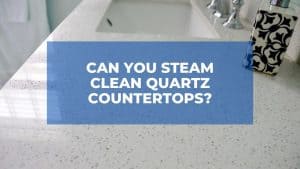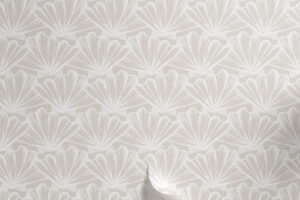Quartz countertops are intricately engineered stone surfaces. They’re made of ground stone particles and a bit of quartz bound together with plastic resins. Quartz countertops compare to marble and granite in charm but are more durable. But their beauty doesn’t hold without proper maintenance, and primarily, regular cleaning.
Steam cleaning has been touted as one of the best ways to get rid of dirt, kill bacteria, sanitize, and disinfect surfaces. If you know this, and you have a quartz countertop at home, you might have asked yourself, “Can I steam clean my quartz countertop?”

Yes, you can. And we describe how to do it correctly in this article. We also educate you on other tricks to keep your quartz countertops shiny and durable.
Quick Navigation
Why Are Quartz Countertops So Good?
Despite myriads of market options, homeowners have an exceptional love for quartz countertops. It prompts the question, “Why are quartz countertops so good?” Well, there are plenty of reasons. And to begin with, quartz countertops offer a perfect balance between durability and beauty.
A significant percentage of homeowners also love it because it requires less maintenance. For example, it doesn’t have to be re-sealed annually like granite countertops.
Quartz countertops are also non-porous, a nature that makes them impervious to liquids; hence, resistant to stains and bacterial growth. You also have a whole lot of color options with quartz countertops when it comes to finding one that matches your kitchen decor.
And when it comes to repairing, they’re the easiest and most cost-effective to repair because you don’t have to spend time matching colors as is the case with granite and other types of countertops. Other boons that give quartz countertops an edge over the rest are:
- They have a more uniform appearance
- They’re friendlier to the environment than most other options
- They can mimic any material
- Cost-effective
How To Steam Clean Quartz Countertops
You now understand more about quartz countertops, including the fact that they’re safe for steam cleaning. It’s now time to answer the question on how to steam clean them correctly and safely. Below are expert-endorsed steps:
a) Get Rid of Crumbs And Spills
Start by removing all visible dirt to clear the surface for smooth cleaning. You can use a microfiber cloth for this. Ensure that you clear the surface of food crumbs, spills, and other visible messes.
b) Prepare The Steam Cleaning Machine
Fill up your steam cleaner’s water reservoir with pure, clean water. Set it to medium temperature settings and plug it in to heat up. Install a toweling bonnet to the head of the steam cleaning machine.
Lastly, hold the steam cleaner’s head over the sink, pull the trigger, and allow all excess water to come out. Hold the trigger until you see steam coming out.
c) Clean Carefully And Thoroughly
Next, begin steam cleaning your quartz countertop methodically. Clean it in distinct sections to ensure that no area is left untouched. Keep an eye on the bonnet attachment to see if it’s getting dirty. If it does, replace it with another one and continue cleaning.
d) Dry The Surface
Use a dry microfiber cloth to wipe the surface dry until you notice it shining. Steam cleaning usually only loosens dirt but does not blow it away. So this is the chance to do so while removing excess water.
e) Wipe The Bottom of Accessories Before Returning Them
Remember to wipe dry the bottom of all accessories, utensils, appliances, etc. before returning them to your clean countertop. It helps to prevent staining.
What Should You Not Use on Quartz Countertops?
Taking good care of quartz countertops comes with dos and don’ts. The dos are already clear from the sections above, and here are the practices you should avoid at all costs.
Harsh Cleaners And Abrasives
Harsh cleaners and abrasives will hurt the surface of your quartz countertop and give it a dull appearance over time. You don’t want this and the best way out is to avoid products like nail polish remover, bleach, turpentine, oven cleaners, and others of the same kind. A rule of the thumb is to keep highly acidic and basic solutions at bay.
Very High Temperatures
Although quartz countertops are resistant to heat, too much of it is dangerous. The resin used to bind quartz countertop components together is made of plastic, which can get damaged at temperatures above 300°F.
Therefore, we recommend that you use your steam cleaner on medium heat settings. Likewise, avoid placing extremely hot objects directly above the surface. You can use trivets for hot pans and mats for crockpots.
Knife Without A Cutting Board
You can be tempted to chop and cut food directly against your quartz countertop because of its hardness. While they’re scratch-resistant, they’re not scratch-proof. Therefore, keep a chopping board nearby in case you want to slice, chop, or cut some food.
What Is The Best Way To Clean Quartz Countertops?
The best way to clean quartz countertops depends on how deeply it’s soiled. But to begin with, regular cleaning is mandatory and can be done using dish soap, warm water, and a rag. And in case of any spills, remember to wipe them off as immediately as you notice them.
For dried gunk, don’t hesitate to scrape them off using a putty knife (which doesn’t hurt the surface). Wipe off grease using a degreaser that is specifically meant for quartz countertops.
For deep stains, a steam cleaner is the safest and most natural option. We’ve already described how to steam clean quartz countertops correctly. Likewise, you can use isopropyl rubbing alcohol or a glass cleaner with a piece of towel and warm water to remove deep-seated stains.
How Do I Restore the Shine on my Quartz Countertop?
Your quartz countertop may lose its shiny appearance upon the use of abrasives, acids, bases, and other unfriendly products. Luckily, this is not the end of its beauty as you can fix the mess however deep it is.
We recommend dedicated quartz polishing compounds alongside diamond polishing pads for lightly scratched surfaces. For deeper scratches, the surface must be filled with epoxy or resin. But in the case of pits, use clear acrylic for filling. And if you can’t do it on your own, don’t hesitate to find an expert to help you fix it.


